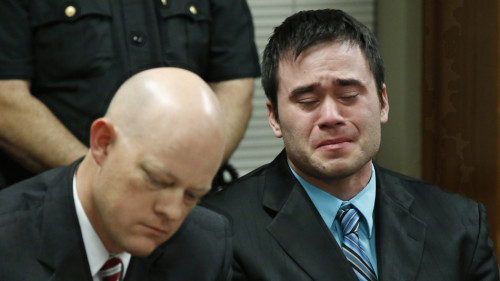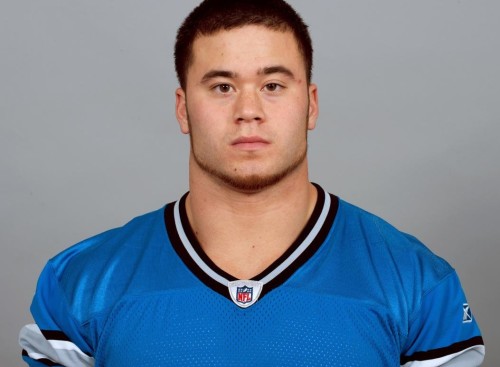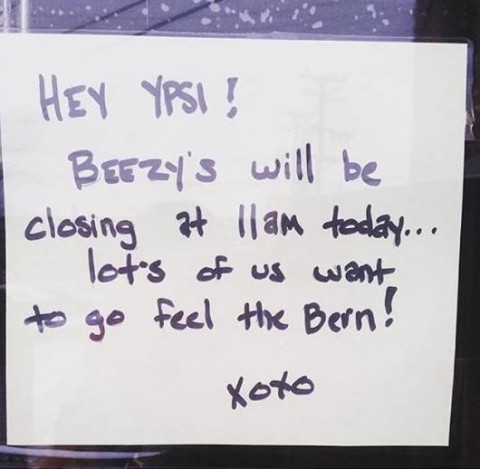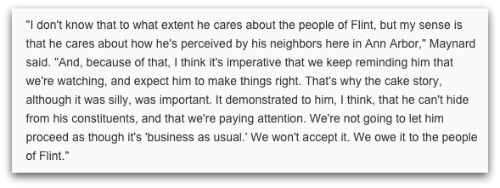I suppose there’s a good chance that all of you already know this, but, up until last night, when I read the controversial SB Nation article about Daniel Holtzclaw, the Oklahoma City police officer who was sentenced last month to 263 years in prison for raping eight women while on duty, I wasn’t aware of the fact that he’d played football and Eastern Michigan University and graduated from the school with a degree in criminal justice.
I hesitate to link to the article, which was written by former Ann Arbor News sports reporter Jeff Arnold, as it comes across as largely sympathetic toward Holtzclaw, who repeatedly used the power of his position as a police officer to take advantage of poor and vulnerable African American women in the community that he had sworn to protect and serve, but I did find much of it interesting, especially as it related to the four years the linebacker spent here, playing for EMU. In particular, I was struck by the suggestion late in the article that Holtzclaw<'s behavior might be attributable, at least in part, to the brain trauma he received while a football player at EMU. [This is one of the many possible excuses the author offers to explain how this otherwise upstanding young man, who was described by his his defense attorney as “naïve and very gullible,” could have possibly done such terrible things.] Before we get to that, though, I want to share this quote from SB Nation Editorial Director Spencer Hall, whose decision it was to pull the article from their site. Arnold's article, according to Hall, was "tone-deaf, insensitive to the victims of sexual assault and rape, and wrongheaded in approach and execution.” And, for what it’s worth, I wholeheartedly agree with that assessment of the piece, which, to a great extent, reads like a desperate attempt to place blame for Holtzclaw’s actions on things like chronic trauma encephalopathy (CTE) and his disappointment at having failed to reach the NFL, rather than on things like racism and a culture that largely turns a blind eye to police violence. With that said, though, I did find the article, which can still be found cached online, to be fascinating… Following, to give you a sense of the piece, are a few excerpts.
First, by way of background, here’s Arnold’s description of how Holtzclaw systematically preyed on vulnerable African American women.
…In each case, women ranging in age from 17 to 57, most with troubled pasts, claimed that at some point during a six-month period between late 2013 and the summer of 2014, each was victimized by a cop who stopped them due to some traffic offense, usually determined their vulnerability due to past offenses, then forced himself on them sexually in exchange for not making their legal issues any worse than they already were…
Jannie Ligons, the grandmother whose initial complaint became a focal point of the state’s case, testified that in the summer of 2014, Holtzclaw pulled her over for erratic driving at 2 a.m., just as his shift ended. Ligons was was on her way home after playing dominoes with friends. During the traffic stop, Ligons, who, unlike other Holtzclaw victims had no criminal record, testified Holtzclaw started to conduct a search during which he ordered the daycare worker to lift her shirt and then remove her pants. Holtzclaw, according to Ligons’ testimony, lowered the beam of his flashlight between her legs before unzipping his pants and ordering her to perform oral sodomy. “Come on,” Ligons testified Holtzclaw said at the time, “I don’t have all night.”
Believing she might be shot if she did not comply, Ligons did as Holtzclaw ordered. She later told local media outlets that all she could see at the time “my life flashing in front of my eyes and the holster on his right side.” In every case, prosecutors maintained Holtzclaw sexually assaulted and raped his victims believing they would be too frightened and intimidated to report him. Ligons, however, was not. Her accusations triggered an internal investigation by the Oklahoma City Police Department’s sex crimes unit that resulted in the 36 charges Holtzclaw faced in court…
And, as I alluded to earlier, here’s Arnold’s suggestion that the behavior described above could be the result of repeated head trauma.
…In 2014, a report on HBO’s Real Sports concluded that former players who exhibit histories with domestic violence and bursts of rage can be linked to CTE, a brain disease caused from repeated blows to the head, but that can only be diagnosed once a player has died. Scientists at Boston University determined, according to the HBO report, that lesions in the anterior temporal lobe of many former players’ brains have been impacted by the constant head trauma. In the report, Dr. Ann McKee, told HBO that when damaged, that part of brain, which controls emotions and self-control, can lead to bouts of anger and aggression…
[In Arnold’s defense, it should be noted that he did go on to say that there was no proof that CTE played a role. “The potential connection in Holtzclaw’s case is intriguing, but hardly certain,” the author said, “and without testing, there is no real way to determine if Holtzclaw is affected, or, even if he is, if that may have played a role in his crimes.”]
While I don’t necessarily want to debate what may have influenced Holtzclaw’s behavior, I do find it worth noting the SB Nation article points toward two specific things that happened to the young man while at EMU that may have been contributing factors. The first, as noted above, was the repeated head trauma he was subjected to as linebacker on the football team. The second involved a program launched by EMU’s then football coach Jeff Genyk, which made late-night ride-alongs with local Ypsilanti police mandatory. As Holtzclaw grew up in a family of police officers, I doubt his exposure to the Ypsi Police Department made that big of an impact, but, as Arnold brings it up, I thought that I should at least mention it. Here’s a clip from the article which goes into more detail.
…Genyk, who came to Eastern Michigan following a stint at as an assistant coach at Northwestern, also instituted a mandatory program in which players took part in police ride-alongs, spending Friday and Saturday nights during the off-season patrolling the surrounding community as a reminder of the trouble that could be found if players went looking for it.
During the required two-hour shifts, players occupied the back seat of county patrol cars as the local cops guided them through a typical night on the job. The rides extended from Eastern Michigan’s campus to Ypsilanti’s neighborhoods and into nearby trailer parks, providing athletes who routinely limited their free time to more sedate parts of town a glimpse into the areas were officers were typically called to respond to trouble.
For some, the experience may have served as just that. But for others, and perhaps for Holtzclaw, a ride through the seedier, poorer side of town might have proven both fascinating and strangely seductive, a place where it is obvious the poor and the powerless are vulnerable and easily victimized. Much more so than (Holtzclaw’s hometown of Enid, Oklahoma), parts of Ypsilanti are marked by poverty. A mixed-race community that is one-third black, 25 percent of the population lives below the poverty line.
Like most cities located near Detroit, Ypsilanti had once been a booming automotive town, where workers flocked to for employment at the local auto factories. The population has dropped by a third since 1970, and General Motors closed down the power train division plant in 2010. Although local officials have attempted to portray Ypsilanti as an idyllic place to live, all parts of the city don’t necessarily fit that mold. There is poverty, there are drugs, and at that intersection, like the section of Oklahoma City Holtzclaw later patrolled as a policeman, there is often crime…
So, maybe, according to Arnold, it’s Ypsilanti’s fault for having been so “strangely seductive”… maybe we share some of the responsibility for making it obvious to Holtzclaw that “the poor and the powerless are vulnerable and easily victimized.” [note: In case it’s not clear, I intended that last sentence to be read with sarcasm.]
Or maybe it’s the fault of the NFL for not having drafted Holtzclaw upon graduation, forcing him back to Oklahoma to become a cop.
…His football career ended at Eastern Michigan, in Ypsilanti. Less than one year after starring in the MAC, he was a former college football player, accent on “former.”
If anything caused Holtzclaw to become unhinged, that may, in part, be what did. For the first time in his life, he had failed and the goal he had long sought was no longer available. For the first time, his strength and will had not been enough. Without an NFL dream to aspire to, perhaps he felt that his sacrifices had been for nothing. As a football player, he had believed he was in charge of his own destiny, now he was stripped of his power.
Without football, Holtzclaw turned to law enforcement, continuing his family’s tradition of turning out police officers, training at the Oklahoma City police academy, where he was hired September of 2011. Yet his failure to play professionally remained a sore subject even as Holtzclaw’s law enforcement career in Oklahoma City was getting underway…
So, yes, it’s a hugely flawed piece. It talks about head trauma and career disappointment, while virtually ignoring racism and the culture of violence within the Oklahoma City police department, which, to me, seem like much more significant factors, especially given what we know about sexual assaults perpetrated by police officers. It also largely ignores the voices of the Holtzclaw’s victims. Arnold, while not suggesting that Holtzclaw is innocent of these crimes, seems to be looking for a explanation as to why this ‘good kid’ may have committed these terrible acts. And, given this, I’m not at all surprised that this story has been roundly criticized. With that said, though, given the local connection, I’m curious to know what people think. Is this a case that people within EMU and our local police department are discussing? And, are we likely to see any change within either institution as a result? Will, EMU, for instance, do more to institute comprehensive anti-rape educational initiatives, not just for its football players, but across campus? And will these police ride-alongs, if that’s something that still happens, be stopped?
[The above photo of Holtzclaw was taken just after leaving EMU, during a Detroit Lions mini-camp. Holtzclaw, who went undrafted after graduation, did earn an invitation to try out for the Lions. The organization, however, chose not to extend an offer.]






















